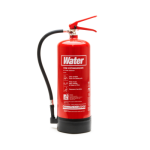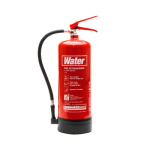Your cart is currently empty!
How Do Water Fire Extinguishers Work?
In an emergency, it’s easy to panic, especially if there are lives at stake. That’s why it’s so important that you’re familiar with how to extinguish a small fire while safely using the right type of extinguisher. For many people, that means grabbing a water fire extinguisher, but is this always the right option?
The science behind different fire types and extinguisher types is worth taking the time to understand. That’s why this month at Fire Safety Equipment, we will explain how water fire extinguishers work, along with more details, so that you can avoid creating a more dangerous situation and purchase the right extinguisher for the job.

How water fire extinguishers put out fires
Water fire extinguishers put out fires using the simple, but effective cooling impact of H2O.
Recalling the fire triangle, a fire needs three things: fuel, oxygen and heat. Water helps to absorb the heat from the fuel in this equation and not, surprisingly, from the actual flames. The impact of this immediate cooling effect on a small fire means that the temperature is simply not high enough to allow the fire to burn, resulting in it going out.
This is why you’re advised to aim the nozzle of a water fire extinguisher at the base of the flames, to allow the water to quickly bring the temperature down. Read more about this in our previous article on the topic of water fire extinguishers.
What type of fires should water extinguishers be used on?
While a water fire extinguisher seems like the most common type because of how our brains think about water and fire being opposites, it’s only safe to use on a few types of fires. This, essentially, comes down to what type of fire it is, i.e. what fuel source is burning.
Water fire extinguishers must only be used on Class A fires. These are fires that involve a flammable, organic solid such as paper, wood and textiles. Some hypothetical examples of items that could catch fire to help you better understand the type of fire we’re talking about include:
- Furniture in a retail unit (wood, textiles)
- Packing materials in a distribution centre (paper, card)
- Rubbish bins in an office space (paper, general waste)
- Carpets being made in a manufacturing plant (textiles)
- Books and chairs in theatres and library spaces (wood, paper)
What type of fires should water extinguishers not be used on?
As we’ve highlighted above, there are only certain fires that a water fire extinguisher can be safely used on. So here are some examples of when not to use one:
- Where electronics and cables are the source of the fire (electrical fires)
- Where cooking oils or fats in a kitchen have caught flame (Class F fires)
- Where paints or flammable liquids are on fire (Class B fires)
- Where a flammable gas is the source of the fire (Class C fires)
- Where combustible metals have ignited (Class D)
There are many reasons you shouldn’t use water on these fire types, including the risk of spreading flames, the chance of electrocution and the ineffective nature of water on fires burning at high temperatures.
The pros and cons of water fire extinguishers
So, if you’re running a shop, a manufacturing plant, or an educational or cultural space, what are the pros and cons of water fire extinguishers that you should know? Here’s our quick breakdown:
Pros – Water fire extinguishers provide rapid cooling and don’t leave behind any type of residue that could negatively impact the environment in the same way a chemical unit might.
Cons – They’re only useful for one class of fire, making them potentially dangerous to use if positioned in other areas such as kitchens or offices.
Are water fire extinguishers effective?
Keeping in mind all of the information above, are water fire extinguishers effective? The answer is yes, but only for one specific fire class. All that this means is that you need to seriously consider the types of risks in your building and plan accordingly. For spaces with lots of organic materials, such as paper, wood and textile, a water extinguisher is great. If you have a combination of risks, you may need multiple extinguishers in place.
You can find three-, six-, and nine-litre water extinguishers right here online at Fire Safety Equipment — we even stock stainless steel units if you want to preserve the visual appearance of your space. We’re your comprehensive supplier of all the crucial equipment your business could ever need to keep your premises safe. Whatever the size and type, you’ll find it in our range of fire extinguishers. And with fast, free delivery in the UK, you won’t have to wait or shop around to get what you need.
Order online today and get quality water fire extinguishers for your business.



